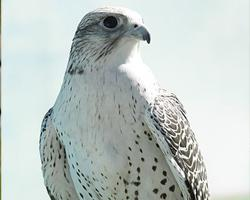
Poids et mesures
| Longueur | de 48 à 65 cm |
|---|---|
| Poids | de 800 à 2100 g |
| Envergure des ailes | de 110 à 130 cm |
Données biologiques
| Durée de vie | 20 r |
|---|
Statut de conservation
| Menacé |
Description de l'animal
The Gyrfalcon (Falco rusticolus) is a magnificent bird of prey, holding the title of the largest of the falcon species. Its majestic appearance, formidable size, and remarkable hunting prowess have fascinated bird enthusiasts and naturalists for centuries. Native to the arctic and subarctic regions of the Northern Hemisphere, the Gyrfalcon has adapted remarkably well to the harsh, frigid environments it calls home.Physical Characteristics:
The Gyrfalcon is a robust bird, with a body length ranging from 20 to 25 inches (51 to 63 cm) and a wingspan that can reach up to 4 feet (1.2 meters), making it a formidable presence in the skies. It exhibits sexual dimorphism, with females being significantly larger than males, a common trait among birds of prey. The Gyrfalcon's plumage is highly variable, ranging from a dappled white, which blends seamlessly with its snowy habitat, to a dark gray or even black coloration. This variability in plumage not only provides excellent camouflage against different backgrounds but also makes the Gyrfalcon a particularly striking bird to observe.
Habitat and Distribution:
The Gyrfalcon's range is circumpolar, spanning the tundra and boreal forests of the Northern Hemisphere. Its preferred habitats include wide-open spaces such as tundra, mountain ranges, and coastal cliffs, where it can leverage its incredible flying abilities to hunt. Despite its preference for cold climates, the Gyrfalcon is somewhat adaptable and can be found in slightly more temperate regions, particularly during the winter months when it may migrate southward from its breeding grounds.
Diet and Hunting Behavior:
The Gyrfalcon is an apex predator, with a diet that primarily consists of medium-sized birds and mammals. Its prey includes ptarmigans, waterfowl, and seabirds, as well as ground squirrels and lemmings. The Gyrfalcon hunts from the air, using its keen eyesight to spot prey from a distance before diving at high speeds, often exceeding 130 mph (209 km/h), to strike with lethal precision. Its hunting strategy showcases not only its physical prowess but also its intelligence and adaptability.
Breeding and Lifespan:
Gyrfalcons are solitary and territorial birds, especially during the breeding season. They nest on cliff ledges, where the female lays a clutch of 3 to 5 eggs. Both parents participate in the rearing of the young, with the male primarily responsible for hunting and providing food. The chicks fledge after approximately 8 to 10 weeks, though they may remain dependent on their parents for a short while thereafter. Gyrfalcons can live up to 20 years in the wild, although their lifespan can be significantly longer in captivity under optimal conditions.
Conservation Status:
Currently, the Gyrfalcon is classified as Least Concern by the International Union for Conservation of Nature (IUCN), indicating a stable global population. However, like many species, it faces threats from habitat destruction, climate change, and pollution, which could impact its prey availability and breeding habitats. Conservation efforts focused on habitat preservation and mitigating climate change are vital to ensuring the long-term survival of this majestic bird of prey.
In conclusion, the Gyrfalcon (Falco rusticolus) is a symbol of the wild, untamed beauty of the arctic and subarctic regions. Its remarkable adaptations, stunning plumage, and awe-inspiring hunting abilities make it a fascinating subject of study and an iconic species among the falcons. As a top predator, the Gyrfalcon plays a crucial role in maintaining the balance of its ecosystem, making its conservation important not only for the species itself but also for the health of the broader environment it inhabits.
Animaux similaires
Nouvelles photos d'animaux
Top 10 des animaux
- Dolphin gull (Leucophaeus scoresbii)
- Diana monkey (Cercopithecus diana)
- Moustached guenon (Cercopithecus cephus)
- Galápagos tortoise (Geochelone nigra complex)
- Japanese macaque (Macaca fuscata)
- Stone loach (Barbatula barbatula)
- Russian tortoise (Testudo horsfieldii)
- Greek tortoise (Testudo graeca)
- Common flying dragon (Draco volans)
- Vendace (Coregonus albula)


